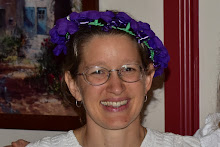Thursday and Friday. I got too busy to blog the last few days of last week. School went on as usual; I introduced another letter for which we made a letter sheet, and I tried to read to the kids about Egypt but they were too antsy to sit still for it. On Saturday we did a lot of walking - P and E badgered me to go for a walk with them in the late morning, and then in the evening we walked to dinner and back, so they probably covered a total of about 4 miles on foot without help over the course of the day. As Ari said, they're the children of hikers who are the children of hikers who are the children of hikers...
Monday. We looked at the letter X in language arts today. Of course, the number of words starting with X is limited, and the number of words starting with both X and the "ks" sound is zero, so we looked for words merely containing the "ks" sound spelled X: fox, six, ox, etc.
We did get to reading about Egypt. We had 2 library books, one written at the kids' level, so I read it to them almost verbatim. Whoever converted the fahrenheit measurements into celsius did not understand the standard formula. Quick poll: does this statement make you wince?
"Hot winds can cause the temperature to rise 68 degrees F (20 degrees C) in just two hours."
Choose one, please. Not both. I don't know for sure which figure is correct, and whether the original figure was given in degrees F or degrees C, though 68 degrees F is more impressive. The author then naively applied the standard conversion formula: Degrees C = (Degrees F - 32) * 5/9 (or the inverse, Degrees F = Degrees C * 9/5 + 32). It's the 32 that got him into trouble. When comparing an increase, you don't need to correct for a different zero point - the result should be that the temperature can rise by about 38 degrees C in just 2 hours (or by 36 degrees F, if the 20 degrees C was the original).
I'm going to write to Scholastic Publishing and alert them to this error (and ask them which figure is correct). I will explain it to them in more detail, using smaller words and bigger pictures, than I did above, because I assume my average blog reader to understand math more deeply than the average book publisher. I'll let you know if I can convince them.
My kids will understand math better than this, if I have anything to do with it. This is one of the joys of homeschooling - you observe the howling ignorance around you, and you say, "I have the power to help at least 3 little people grow up to not exhibit that particular type of howling ignorance." I won't let them just plug and chug into a formula they don't understand.
P enjoyed making her Egypt book, particularly once she realized she could write her name in hieroglyphics. She drew a flag, coloured a map (she coloured the area around the Nile green, and the rest yellow, adding little red "rooftops" clustered around the Nile delta to show that more people lived there), and drew the Sphinx, the Nile, her name in hieroglyphics (she asked me to write "hieroglyphics" for her - a bit intimidating for a 5-year-old), the pyramids, and the Sahara Desert. She then copied down all the hieroglyphics and their equivalents that were listed in the library book and that weren't too complicated-looking (she left the bird drawings alone). I suggested taking the book back to the library this afternoon, but she wanted to keep it in order to keep playing with hieroglyphics.
Tomorrow, we plan on driving to San Antonio to visit Sea World. Should be fun!
Subscribe to:
Post Comments (Atom)


Things like this are make it very gratifying to be a teacher. Maybe you have a teaching career yourself once you've gotten your own 3 little non-howlers raised! :)
ReplyDelete